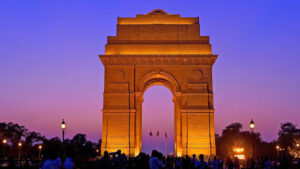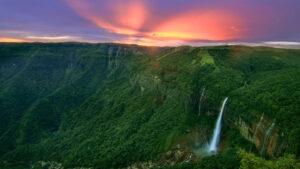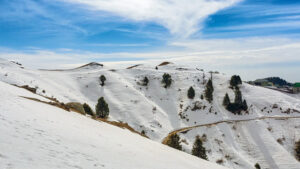KAZIRANGA NATIONAL PARK, ASSAM – HOME TO THE ONE HORNED RHINO

Kaziranga National Park is a UNESCO World Heritage Site located in the Indian state of Assam. It is one of the most popular national parks in India and is known for its incredible biodiversity, including the world’s largest population of one-horned rhinoceroses. The park covers an area of approximately 430 square kilometers and is home to a variety of wildlife, including tigers, elephants, wild water buffalo, swamp deer, and over 400 species of birds.

Kaziranga is situated on the banks of the Brahmaputra River and is surrounded by lush forests and rolling hills. It was established in 1905 as a reserve forest and was declared a national park in 1974. In addition to its wildlife, the park is also known for its beautiful landscapes, including grasslands, wetlands, and dense forests.
Kaziranga is a popular destination for wildlife enthusiasts, nature lovers, and adventure seekers. Visitors can explore the park on jeep safaris, elephant rides, or on foot with a guide. There are several observation towers and hides throughout the park that offer excellent opportunities for wildlife spotting and birdwatching.
Overall, Kaziranga National Park is a must-visit destination for anyone interested in nature and wildlife. With its incredible biodiversity and beautiful landscapes, it is truly a unique and special place in the world.
Wildlife Safari
Wildlife safari is one of the most popular activities in Kaziranga National Park. Visitors can explore the park’s diverse wildlife and beautiful landscapes on a jeep safari or an elephant ride. Here are some important things to know about wildlife safaris in Kaziranga:
- Safari timings: Wildlife safaris in Kaziranga are typically conducted in two shifts – morning and afternoon. The morning shift usually starts around 7:30 am and ends by 10:00 am, while the afternoon shift starts around 1:30 pm and ends by 4:00 pm. However, the timings may vary depending on the season.
- Safari duration: A typical safari in Kaziranga lasts for about two hours. However, the duration may vary depending on the package you choose.

- Safari booking: It is recommended to book your safari in advance to avoid any last-minute hassle. Safari bookings can be made online through the official website of Kaziranga National Park or in person at the booking counters located at the park entrance.
- Safari zones: Kaziranga National Park is divided into four safari zones – Kohora, Bagori, Agaratoli, and Burapahar. Each zone has its own unique flora and fauna, and visitors can choose the zone they wish to explore during their safari.
- Safari rules: Visitors are required to follow certain rules and regulations during their safari, such as not getting off the jeep or elephant, not disturbing the wildlife, and not carrying any plastic or non-biodegradable items inside the park.
Other Activities
Apart from wildlife safaris, there are several other activities that visitors can enjoy in and around Kaziranga National Park. Here are some of the popular ones:
- Birdwatching: Kaziranga is home to over 400 species of birds, making it a paradise for birdwatchers. Visitors can spot a variety of birds, including several endangered species like the Bengal florican and the lesser adjutant stork.
- Trekking: There are several trekking routes in and around Kaziranga that offer visitors a chance to explore the park’s natural beauty up close. Trekking is usually conducted in the surrounding hills and forests, and visitors can hire a guide for the same.

- Cycling: Cycling is a popular activity in and around Kaziranga, and visitors can rent bicycles and explore the park at their own pace. Cycling is a great way to get some exercise and enjoy the park’s beautiful landscapes.
- Village tours: Visitors can take a tour of the nearby villages and learn about the local culture and way of life. The villages in the surrounding areas are known for their handicrafts, traditional music, and dance forms.
- River cruises: Visitors can take a cruise on the Brahmaputra River and enjoy the scenic views of the park and its surroundings. The river cruises are usually conducted in the early mornings or late evenings.
Nearby Places to See
Kaziranga National Park is located in the northeastern state of Assam in India, and there are several nearby places that visitors can explore. Here are some of the popular ones:
- Majuli Island: Located on the Brahmaputra River, Majuli Island is the world’s largest river island and is known for its vibrant culture, traditional music and dance forms, and beautiful landscapes.
- Sivasagar: Sivasagar is a historic town located about 75 km from Kaziranga National Park. It is known for its rich history and cultural heritage, with several temples and monuments dating back to the Ahom Kingdom.

- Pobitora Wildlife Sanctuary: Pobitora Wildlife Sanctuary is located about 50 km from Kaziranga National Park and is known for its population of one-horned rhinoceroses. Visitors can enjoy wildlife safaris and birdwatching at the sanctuary.
- Jorhat: Jorhat is a bustling city located about 90 km from Kaziranga National Park. It is known for its tea gardens, cultural attractions, and historical landmarks like the Jorhat Gymkhana Club and the Tocklai Tea Research Institute.
- Gibbon Wildlife Sanctuary: Gibbon Wildlife Sanctuary is located about 140 km from Kaziranga National Park and is known for its population of hoolock gibbons. Visitors can enjoy wildlife safaris and birdwatching at the sanctuary.
Best Time to Visit
The best time to visit Kaziranga National Park is from November to April, which is the park’s peak tourist season. During this time, the weather is dry and pleasant, and visitors can enjoy wildlife sightings and outdoor activities like safaris, birdwatching, and trekking.

The park remains closed from May to October due to the monsoon season, as heavy rainfall leads to flooding and makes it difficult to access the park. The park also remains closed during the biennial census of the one-horned rhinoceros, which is usually conducted in March and April.
It’s important to note that the weather in Kaziranga can be unpredictable, and visitors should be prepared for sudden rain showers or drops in temperature. It’s recommended to carry warm clothes and rain gear, especially during the winter months.


















































